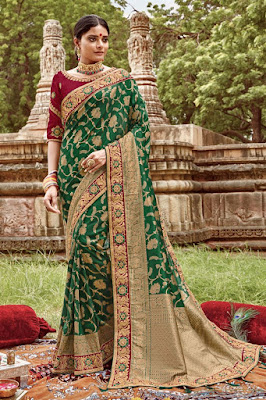All You Need To Know About An Indian Sarees
The clothing in India is widely
associated with climate, temperature, culture, and religion. The traditional
Indian clothing is saris, salwar kameez, and lehenga choli. Women wear sari
which is a long 5 to 6 yards of clothing and is draped in different styles at
different places accompanied by a blouse and a petticoat. The trend of wearing
a sari in a simple yet innovative manner is still followed in rural areas,
though it is changing in the urban areas nowadays. Before attaining the age of
puberty girls wear a long skirt which is called lehenga and a short blouse,
known as choli. Girls in their teenage wear half saris, as a lehenga, a choli
and a stole wrapped around the body as a sari. Women especially the married
ones wear full long Indian sarees
which go down till the ankle.
A saree or sari is female clothing that
is worn by the women of the Indian subcontinent as their staple dress. The word
sari is derived from the Sanskrit language which means 'strip of a cloth', and
which was corrupted to sari in the Hindi language. There is an end of the
fabric that is held loose in many styles of draping it and this loose end is
decorated with sequins, a stone, embroidery, etc. and this loose end is known
as palla. It is generally pinned and pleated on to the one side of the shoulder
or it is left loose at one end and draped over the arm.
A saree is solely ancient Indian
apparel that has not lost its charm till now. It can be worn in various styles
and patterns of fabric. Different materials are used for different kinds of
sarees. Embroidered, beaded, stonework or sequined are many various sarees
you'll be able to see nowadays in various stores and online. Designers have
crafted different sarees for various occasions and themes. A designer label
surely brings up an excellent piece of art and exotic, delicate and inventive
work on the saree itself. So, women can purchase them without any second
thought.
Every place in India is famous for its
fabric and the carving and the way a sari is crafted. The most popular and
traditional types of sarees are the Kanjeevaram (Kanchipuram), from south
India. This sari is made of heavy silk from the silkworm and has a broad border
and contrasting colors. Patterns on the sari pallu are derived from temples,
palaces, and paintings.
Another one is the Banarasi sari, which
is handwoven in Banaras. These saris are known for their colorful dyed silk
fabric. Designs of villages, flowers, and temples are carved on the saree.
Another type of sari is the bright
tie-dyed Bandhani/Bandhej saris from Rajasthan and Gujarat, cotton Gadhwal
saris with silk borders and pallu from Andhra Pradesh, and the fine silk and
gold weaved Paithani saree with peacock
designs from Maharastra.
The most vibrant feature in a sari is
the zari (gold thread) work in them. This gold thread is woven through the
sari, mostly on the borders and pallu. The trend of zari traditionally comes
from Surat, in the state of Gujurat.
One can pick up a saree for just rupees
150 but one needs to fetch a little more if to go for good quality. To buy a
beautiful sari in India it is not expensive as compared to the West. The price
of a sari is affected by the type of fabric that it’s made out of. Printed silk
saris are available from 1,500 rupees to 2000 rupees. A sari which has thread
work embroidery into it costs more, with the increase in the embroidery done on
the saree and the vice versa. If the sari has zari in it, the cost is higher
according to the amount of effort put in it.
We can see lots of imitated sarees can
be for Kanjeevaram saree too. The important thing to check while seeing whether
the saree is real or not is the quality of the silk and zari in the sari. When
checked closely, the silk may be felt thick and glossy near the palla but
inside allover the sari, one may find that the silk is half in thickness as
compared with the silk in the palla. Various weaver and retailers use two-ply
silk instead of three-ply for weaving and fake gold thread for the zari work.
The zari used for a Kanjeevaram sari is
a silk thread which is covered with a silver in the center, and gold on the
outer surface. To test whether the zari is fake or artificial, scratch or
scrape it and if red silk doesn't emerge, then the sari is not a true
Kanjeevaram sari. Besides, the border, body, and palla of a genuine Kanjeevaram silk saree are woven
separately and then attached.
This attire is in style since 1000
years ago for the simple reason of its simplicity, uniqueness and practical
usage with the women of today's fast-moving world.






Comments
Post a Comment